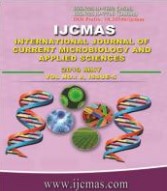


 National Academy of Agricultural Sciences (NAAS)
National Academy of Agricultural Sciences (NAAS)

|
PRINT ISSN : 2319-7692
Online ISSN : 2319-7706 Issues : 12 per year Publisher : Excellent Publishers Email : editorijcmas@gmail.com / submit@ijcmas.com Editor-in-chief: Dr.M.Prakash Index Copernicus ICV 2018: 95.39 NAAS RATING 2020: 5.38 |
This study was undertaken to determine the ecological potentials of beekeeping in Mayo-Belwa local Government Area of Adamawa state. Following the randomly selection of two districts based on the existing forest reserves in the local government area, the inventory of plant resources at both woody and herbaceous layer were made to prepare the list of plant resources utilized by honeybees, determine density of both tree and shrub species as well as estimate the cover of herbaceous plant species in the study area. Total count methods were done for trees and shrubs, while herbaceous plant cover was estimated in quadrat by the ocular estimate method. Secondary data on precipitation, Temperature and Relative humidity were collected from the nearest meteorological station to the study site and also the yield of honey were obtained from the beekeepers in the study area. Descriptive statistics, analysis of variance and multiple regressions were employed for analysis. Results obtained showed that 14 species of trees belong to 10 families, 11 species of shrubs under 7 families and 6 species of herbaceous plants from 4 families were identified as plants utilized by honeybees in the study area. Among the trees inventoried, 85.7% and 92.9% were utilized by bees in districts 1 and 2 respectively, while 90.9% and 81.8% of shrubs were also utilized by bees in the study area. 70.4% and 58.8% of herbaceous plant cover were utilized by honeybees in the study area while Precipitation (-0.207ns) and temperature (-3.476ns) had no significant on the yield of honey, the effect of tree density on yield of honey was significant (0.524*) and that of Relative humidity was highly significant (1.492**) (P<0.05). The results showed that the study area has ecological potentials for beekeeping. To improve the beekeeping in the study area, training programs either through workshops or extension services are recommended.
 |
 |
 |
 |
 |